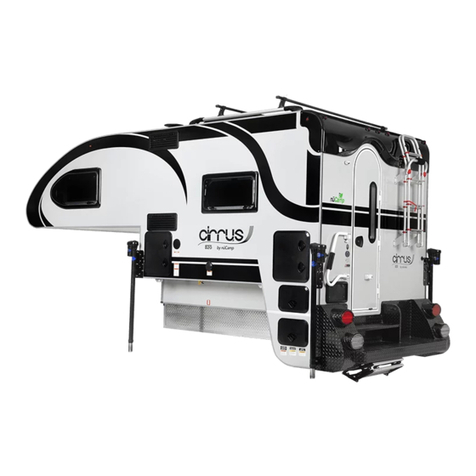
Disclaimers.............................................2
Copyright................................................2
INTRODUCTION
Welcome ................................................3
Beginning Your Journey ........................3
Our Mission............................................3
FOREWORD
About This Manual .................................5
GETTING STARTED
Dealer Responsibility.............................6
Owner Responsibility..........................6-7
Owner Packet .........................................7
Warranty Registration............................7
Component Registrations......................7
Fire Safety Plan ......................................7
Emergencies....................................... 8-9
GENERAL SAFETY
Safety Certications.............................10
Safety Messages ..................................10
Fire Safety .......................................10-11
Fire Extinguisher..................................11
Emergency Exit Window................. 11-12
Smoke Alarm........................................12
Carbon Monoxide ...........................12-13
CO & LP Gas Alarm ...............................13
LOADING & HAULING
Vehicle Match.......................................14
Rig Dynamics .......................................16
Driving Practices .............................16-17
Electric Jack System ........................17-18
Additional Equipment..........................18
Weight Denitions ...............................18
Carrying Cargo.....................................19
Camper Loading..............................19-20
Connector Plug ....................................21
Stabilizing & Setup...............................21
HEATING & COOLING
Alde® Heating System ................... 22-23
Alde® Flow............................................23
Air Conditioning............................. 23-24
Fan Ventilation .....................................24
PLUMBING
Water System Information & Safety ..25-26
Monitor Screen.....................................26
Fresh Water Tank..................................26
Water Fill ..............................................26
Water Pump ................................... 26-27
Shower .................................................27
Exterior Wash Station......................27-28
Hot Water & Mixing Valve ....................28
Waste Water Tanks ......................... 28-29
Toilet.....................................................29
Winterizing/De-winterizing .................29
PROPANE GAS
LP Safety...............................................30
Filling LP Tanks............................... 30-31
Propane Regulator ......................... 31-32
Propane System Maintenance ............32
Propane Usage.....................................32
ELECTRICAL
Electrical Safety & Information ............33
120V AC Shore Power...........................33
12V DC System.....................................34
Battery .................................................34
Battery Disconnect Switch ...................35
Power Distribution Center ...................35
Converter........................................35-36
Ground Fault Circuit Interrupter ..........36
Receptacles ..........................................36
Inverter.................................................36
nuCamp Control Panel(s).....................36
Safety Lights.........................................37
Interior Lights.......................................37
Entertainment System .........................37
Cable Satellite Connection ..................37
APPLIANCES
Range/Cooktop ....................................38
Microwave Oven...................................39
Refrigerator/Freezer.............................39
EQUIPMENT & HARDWARE
Standard Dinette/Bed Conversion...... 40
Lagun Dinette/Bed Conversion........... 40
Battery Storage Box .............................41
Awnings................................................41
Hardware Adjustments ........................41
INTERIOR ENVIRONMENT
Prolonged Occupancy..........................42
Air Quality ............................................42
Condensation.......................................43
Mold.................................................... 44
Outgassing.......................................... 44
Chemical Sensitivity............................ 44
Formaldehyde......................................45
Pets.......................................................45
MAINTENANCE
Cleaning Care.................................46-47
Storage Preparation............................ 48
Camping Season Preparation ..............49
Maintenance Schedule ........................50
Maintenance Record ............................51
TROUBLESHOOTING
Alde® System .......................................52
Plumbing System.................................52
Electrical System ..................................53
Propane Gas System ............................53
SERVICE & WARRANTY
nuCamp Warranty Information...... 54-57
Replacement Parts...............................57
Aftermarket Alterations........................57
Dealer Service Center...........................58
nuCamp Service Center .......................58
Contacting Us.......................................58
REPORTING SAFETY
DEFECTS........................................59
GLOSSARY...............................60-61
ABOUT THIS MANUAL
The Operator’s Manual for your new camper is designed to answer the most frequently asked questions
regarding the operation, function, and care of the many systems that make modern camping a
pleasure.
For more complete instructions regarding safety, maintenance and operation of the items included in
your camper, carefully read the booklets supplied by the component manufacturers. All information
contained in this manual may not relate to your specic model; however, booklets supplied by the
component manufacturers and included in your Owner’s Packet will provide any additional information
needed. These manuals and iers supersede all statements in this manual and are the ultimate guide to
heed in relation to each appliance and component. You are responsible for reading, understanding and
following the instructions pertaining to the tow vehicle as well as the instructions in this manual.
All information in this handbook should be considered a permanent part of the trailer and should be
transferred to the new owners if the trailer is ever sold.
Optional items may be available on some or all models. Additionally, some optional items can only
be included during the manufacturing phase and cannot later be added to the trailer. The mention
of optional items in this manual does not imply or suggest the availability, application suitability, or
inclusion for any specic unit.
All operating procedures in this manual are designed as typical under normal conditions. Safe
operation and use of any nuCamp camper is the sole responsibility of the owner. nuCamp will not be
liable for any injury or loss sustained from the observance or non-observance of any procedures or
safety warnings supplied in this manual or in any third-party manuals or guides supplied within the unit.
This manual may have occasional tips to enhance your experience of the recreational and camping
lifestyle. While this may be helpful, this manual is not designed as a camping guide but rather as a
guide in how to operate your camper for maximum enjoyment.
This manual does not in any way create a warranty, whether express or implied. The information in
this manual is not meant in any way to supplement, modify, or change the terms and conditions of
your camper’s warranty, or any warranties offered on any component by its manufacturer.
At nuCamp we actively work to provide improved and better information about the use of our
products. If you have helpful information that you think may benet fellow nuCamp product owners,
you may submit it via e-mail to customerservice@nucamprv.com with a subject of “Owner’s Manual”
and your submission will be considered for the next update.
FOREWORD































